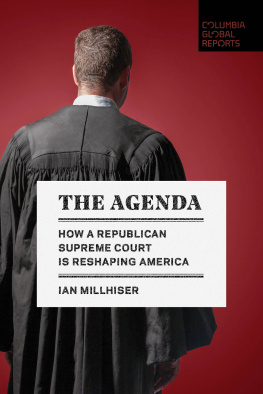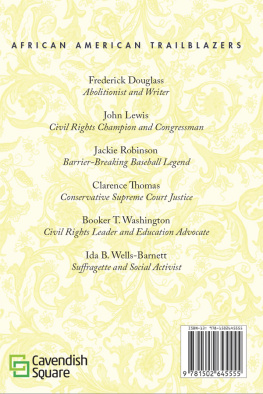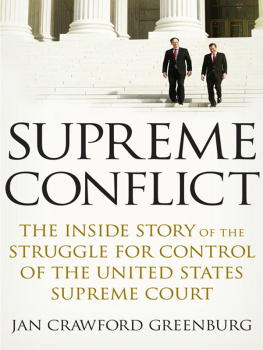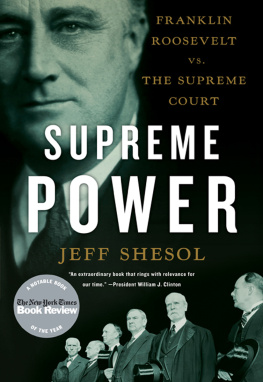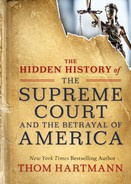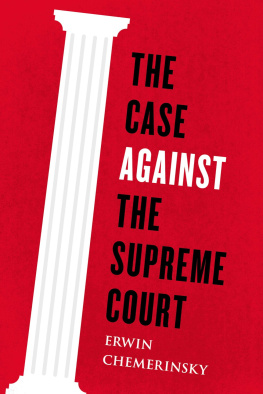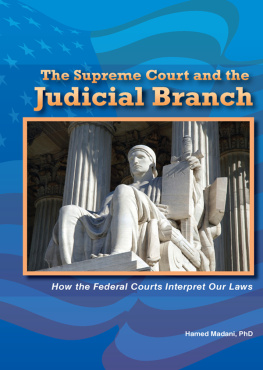Contents
Page List
Guide
The Agenda
How a Republican Supreme Court Is Reshaping America
COLUMBIA GLOBAL REPORTS
NEW YORK
The Agenda
How a Republican Supreme Court Is Reshaping America
Ian Millhiser
The Agenda:
How a Republican Supreme Court Is Reshaping America
Copyright 2021 by Ian Millhiser
All rights reserved
Published by Columbia Global Reports
91 Claremont Avenue, Suite 515
New York, NY 10027
globalreports.columbia.edu
facebook.com/columbiaglobalreports
@columbiaGR
Library of Congress Cataloging-in-Publication Data
Names: Millhiser, Ian, author.
Title: The Agenda: How a Republican Supreme Court is Reshaping America / Ian Millhiser. Description: New York, NY : Columbia Global Reports, [2021] | Includes bibliographical references. |
Identifiers: LCCN 2020055178 | ISBN 9781734420760 (paperback) | ISBN 9781734420777 (ebook)
Subjects: LCSH: United States. Supreme Court. | Judges--United States--Attitudes. | Conservatism--United States.
Classification: LCC KF8748 .M55 2021 | DDC 347.73/26--dc23
LC record available at https://lccn.loc.gov/2020055178
Book design by Strick&Williams
Map design by Jeffrey L. Ward
Author photograph by Holley Matthews
Printed in the United States of America
CONTENTS
Chapter One
The Right to Vote
Chapter Two
Dismantling the Administrative State
Chapter Three
Religion
Chapter Four
The Right to Sue
Introduction
From 2011, when Republicans gained control of the House of Representatives and denied President Barack Obama a governing majority, until the pandemic forced Congresss hand in 2020, Congress enacted hardly any major legislation outside of the tax law President Donald Trump signed in 2017.
In the same period, the Supreme Court dismantled much of Americas campaign finance law, severely weakened the Voting Rights Act, permitted states to opt out of the Affordable Care Acts Medicaid expansion, created a new religious liberty doctrine permitting someone who objects to the law on religious grounds to diminish the rights of third parties, weakened laws shielding workers from sexual and racial harassment, expanded the right of employers to shunt workers with legal grievances into a privatized arbitration system, undercut public sector unions ability to raise funds, effectively eliminated the presidents recess appointment power, and halted President Obamas Clean Power Plan.
Plus, lest you think that the last decade was a never-ending stream of losses for liberals, the Court held that every state must permit same-sex couples to marry, and it held that federal anti-discrimination law prohibits employers from firing individuals because of their sexual orientation or gender identity.
The Supreme Court, in other words, has become the locus of policymaking in the United States. The lions share of the legal changes that have occurred over the last decade were spearheaded, not by elected officials, but by the nine unelected members of the nations highest Court.
And, with Republicans now controlling two-thirds of the seats on the Supreme Court, the Court could potentially sabotage any policy initiative pushed by President Joe Biden. It can also manipulate our voting rights laws to ensure that Republicans dominate future elections.
Part of the explanation for the shift in power from the elected branches to the judiciary is that congressional dysfunction fosters judicial dominance. As Professor Rick Hasen explains in a 2012 study, Congress is now nearly 80 percent less likely to enact legislation overriding a Supreme Court decision than it was several decades ago. Hasen defined the term override to include any successful piece of federal legislation [that] overturned, reversed, or modified a Supreme Court statutory interpretation holding.
Between 1975 and 1990, Congress enacted an average of twelve overrides of Supreme Court cases in each two-year Congressional term. That number shrunk to 5.8 overrides for each term from 1991 to 2000, and to a mere 2.8 average number of overrides for each term from 2001 to 2012.
As Congress has grown more partisan and more polarized, Hasen explained, its become less and less able to form the consensus necessary to override an erroneous Supreme Court decision. Though there are still rare cases where a single political party controls both Congress and the presidency, and the members of that party agree that a particular Supreme Court decision should be overruled, partisanship seems to have strongly diminished the opportunities for bipartisan overrides of Supreme Court cases, in which Democrats and Republicans come together to reverse the Supreme Court.
As Congress grows less and less able to enact ordinary legislation, the Supreme Court is more and more likely to become the final word on questions of policy.
Hasens study, however, only offers a partial explanation of the Supreme Courts increasing dominance. Congress, after all, only has the power to override court decisions interpreting (or misinterpreting) a federal statute. When the Supreme Court declares a law unconstitutional, that decision can only be overruled by the Supreme Court itselfor, in extraordinarily rare instances, by a constitutional amendment.
The full story of how the Supreme Court grew into the most important policymaking body in the United States is also a story about partisan polarization. It is a story about how the justicesand the men who appointed those justicesthemselves became polarized.
For much of the last several decades, Democrats and Republicans largely shared a bipartisan consensus that the courts should play a limited role in society. Indeed, if anything, Republicans tended to be more skeptical of judicial power than their Democratic counterparts. President Richard Nixon campaigned against judges who impose their social and political viewpoints upon the American people. President Ronald Reagan promised judges who would exercise judicial restraint. President George W. Bush warned of judges who give in to temptation and make law instead of interpreting.
Indeed, until very recently, conservative lawyers organized around the principle that courts should be very cautious about exercising too much power. In a 2006 address to the conservative Federalist Society, for example, former federal appellate judge and then secretary of homeland security Michael Chertoff credited the society for catapulting arguments for judicial restraint into the legal mainstream. In large part because of the work that the Society and others have done, Chertoff claimed, the claim for judicial modesty is sufficiently well-established that everybody understands, even the critics of that claim, that they have to take it seriously and they have to address it.
But judicial modesty is now very much out of fashion in conservative legal circles. Many of the same men and women who spent the second Bush administration arguing that judges need to exercise judicial restraint are now the most vocal advocates for increased judicial power. In 2005, for example, future justice Neil Gorsuch denounced American liberals who have become addicted to the courtroom, relying on judges and lawyers rather than elected leaders and the ballot box, as the primary means of effecting their social agenda on everything from gay marriage to assisted suicide to the use of vouchers for private-school education.

